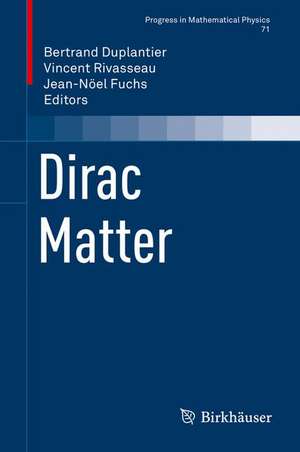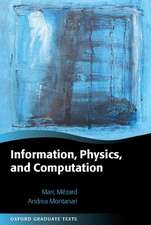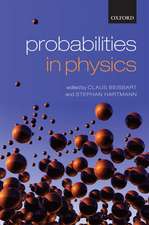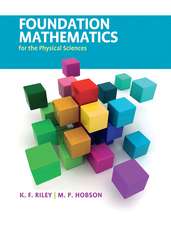Dirac Matter: Progress in Mathematical Physics, cartea 71
Editat de Bertrand Duplantier, Vincent Rivasseau, Jean-Nöel Fuchsen Limba Engleză Hardback – feb 2017
mechanics. In five highly pedagogical articles, as befits their origin in lectures to a broad scientific audience, this book explains why Dirac matters. Highlights include the detailed "Graphene and Relativistic Quantum Physics", written by the experimental pioneer, Philip Kim, and devoted to graphene, a form
of carbon crystallized in a two-dimensional hexagonal lattice, from its discovery in 2004-2005 by the future Nobel prize winners Kostya Novoselov and Andre Geim to the so-called relativistic quantum Hall effect; the review entitled "Dirac Fermions in Condensed Matter and Beyond", written by two prominent theoreticians, Mark Goerbig and Gilles Montambaux, who consider many other materials than graphene, collectively known as "Dirac matter", and offer a thorough description of the merging transition of Dirac cones that occurs in the energy spectrum, in various experiments involving stretching of the microscopic hexagonal lattice; the third contribution, entitled "Quantum Transport in Graphene: Impurity Scattering as a Probe of the Dirac
Spectrum", given by Hélène Bouchiat, a leading experimentalist in mesoscopic physics, with Sophie Guéron and Chuan Li, shows how measuring electrical transport, in particular magneto-transport in real graphene devices - contaminated by impurities and hence exhibiting a diffusive regime - allows one to deeply probe the Dirac nature of electrons. The last two contributions focus on topological insulators; in the authoritative "Experimental Signatures of Topological Insulators", Laurent Lévy reviews recent experimental progress in the physics of mercury-telluride samples under strain, which demonstrates that the surface of a three-dimensional topological insulator hosts a two-dimensional massless Dirac metal; the illuminating final contribution by David Carpentier, entitled "Topology of Bands in Solids: From Insulators to Dirac Matter", provides a geometric description of Bloch wave functions in terms of Berry phases and parallel transport, and of their topological classification in terms of invariants such as Chern numbers, and ends with a perspective on three-dimensional semi-metals as described by the Weyl equation. This book will be of broad general interest to physicists, mathematicians, and historians of science.
| Toate formatele și edițiile | Preț | Express |
|---|---|---|
| Paperback (1) | 576.58 lei 6-8 săpt. | |
| Springer International Publishing – 12 iul 2018 | 576.58 lei 6-8 săpt. | |
| Hardback (1) | 582.63 lei 6-8 săpt. | |
| Springer International Publishing – feb 2017 | 582.63 lei 6-8 săpt. |
Din seria Progress in Mathematical Physics
-
 Preț: 377.18 lei
Preț: 377.18 lei -
 Preț: 398.92 lei
Preț: 398.92 lei -
 Preț: 395.25 lei
Preț: 395.25 lei -
 Preț: 391.02 lei
Preț: 391.02 lei -
 Preț: 396.62 lei
Preț: 396.62 lei -
 Preț: 396.62 lei
Preț: 396.62 lei - 20%
 Preț: 481.50 lei
Preț: 481.50 lei -
 Preț: 399.29 lei
Preț: 399.29 lei -
 Preț: 391.02 lei
Preț: 391.02 lei -
 Preț: 381.98 lei
Preț: 381.98 lei - 18%
 Preț: 1239.85 lei
Preț: 1239.85 lei - 18%
 Preț: 1118.93 lei
Preț: 1118.93 lei - 15%
 Preț: 649.87 lei
Preț: 649.87 lei - 15%
 Preț: 575.10 lei
Preț: 575.10 lei - 18%
 Preț: 786.18 lei
Preț: 786.18 lei - 15%
 Preț: 656.10 lei
Preț: 656.10 lei -
 Preț: 395.25 lei
Preț: 395.25 lei -
 Preț: 382.18 lei
Preț: 382.18 lei - 15%
 Preț: 648.56 lei
Preț: 648.56 lei - 15%
 Preț: 649.06 lei
Preț: 649.06 lei - 15%
 Preț: 645.60 lei
Preț: 645.60 lei -
 Preț: 392.21 lei
Preț: 392.21 lei - 15%
 Preț: 595.86 lei
Preț: 595.86 lei -
 Preț: 409.13 lei
Preț: 409.13 lei - 15%
 Preț: 690.62 lei
Preț: 690.62 lei - 15%
 Preț: 704.69 lei
Preț: 704.69 lei - 15%
 Preț: 654.43 lei
Preț: 654.43 lei - 15%
 Preț: 646.30 lei
Preț: 646.30 lei -
 Preț: 398.35 lei
Preț: 398.35 lei -
 Preț: 402.76 lei
Preț: 402.76 lei - 15%
 Preț: 588.50 lei
Preț: 588.50 lei -
 Preț: 388.72 lei
Preț: 388.72 lei - 18%
 Preț: 781.62 lei
Preț: 781.62 lei -
 Preț: 408.16 lei
Preț: 408.16 lei -
 Preț: 391.79 lei
Preț: 391.79 lei
Preț: 582.63 lei
Preț vechi: 685.45 lei
-15% Nou
Puncte Express: 874
Preț estimativ în valută:
111.48€ • 116.82$ • 92.16£
111.48€ • 116.82$ • 92.16£
Carte tipărită la comandă
Livrare economică 11-25 aprilie
Preluare comenzi: 021 569.72.76
Specificații
ISBN-13: 9783319325354
ISBN-10: 3319325353
Pagini: 129
Ilustrații: XII, 129 p. 45 illus., 44 illus. in color.
Dimensiuni: 155 x 235 x 10 mm
Greutate: 0.38 kg
Ediția:1st ed. 2017
Editura: Springer International Publishing
Colecția Birkhäuser
Seria Progress in Mathematical Physics
Locul publicării:Cham, Switzerland
ISBN-10: 3319325353
Pagini: 129
Ilustrații: XII, 129 p. 45 illus., 44 illus. in color.
Dimensiuni: 155 x 235 x 10 mm
Greutate: 0.38 kg
Ediția:1st ed. 2017
Editura: Springer International Publishing
Colecția Birkhäuser
Seria Progress in Mathematical Physics
Locul publicării:Cham, Switzerland
Cuprins
Philip Kim: Graphene and Relativistic Quantum Physics.- Mark Goerbig and Gilles Montambaux : Dirac Fermions in Condensed Matter and Beyond.- Chuan Li, Sophie Guéron, Hélène Bouchiat : Quantum Transport in Graphene : Impurity Scattering as a Probe of the Dirac Spectrum.-Laurent Lévy : Experimental Signatures of Topological Insulators.- David Carpentier :Topology of Bands in Solids: From Insulators to Dirac Matter.
Textul de pe ultima copertă
This fifteenth volume of the Poincare Seminar Series, Dirac Matter, describes the surprising resurgence, as a low-energy effective theory of conducting electrons in many condensed matter systems, including graphene and topological insulators, of the famous equation originally invented by P.A.M. Dirac for relativistic quantum
mechanics. In five highly pedagogical articles, as befits their origin in lectures to a broad scientific audience, this book explains why Dirac matters. Highlights include the detailed "Graphene and Relativistic Quantum Physics", written by the experimental pioneer, Philip Kim, and devoted to graphene, a form
of carbon crystallized in a two-dimensional hexagonal lattice, from its discovery in 2004-2005 by the future Nobel prize winners Kostya Novoselov and Andre Geim to the so-called relativistic quantum Hall effect; the review entitled "Dirac Fermions in Condensed Matter and Beyond", written bytwo prominent theoreticians, Mark Goerbig and Gilles Montambaux, who consider many other materials than graphene, collectively known as "Dirac matter", and offer a thorough description of the merging transition of Dirac cones that occurs in the energy spectrum, in various experiments involving stretching of the microscopic hexagonal lattice; the third contribution, entitled "Quantum Transport in Graphene: Impurity Scattering as a Probe of the Dirac
Spectrum", given by Hélène Bouchiat, a leading experimentalist in mesoscopic physics, with Sophie Guéron and Chuan Li, shows how measuring electrical transport, in particular magneto-transport in real graphene devices - contaminated by impurities and hence exhibiting a diffusive regime - allows one to deeply probe the Dirac nature of electrons. The last two contributions focus on topological insulators; in the authoritative "Experimental Signatures of Topological Insulators", Laurent Lévy reviews recent experimental progress in the physics of mercury-telluride samples under strain, which demonstrates that the surface of a three-dimensional topological insulator hosts a two-dimensional massless Dirac metal; the illuminating final contribution by David Carpentier, entitled "Topology of Bands in Solids: From Insulators to Dirac Matter", provides a geometric description of Bloch wave functions in terms of Berry phases and parallel transport, and of their topological classification in terms of invariants such as Chern numbers, and ends with a perspective on three-dimensional semi-metals as described by the Weyl equation. This book will be of broad general interest to physicists, mathematicians, and historians of science.
mechanics. In five highly pedagogical articles, as befits their origin in lectures to a broad scientific audience, this book explains why Dirac matters. Highlights include the detailed "Graphene and Relativistic Quantum Physics", written by the experimental pioneer, Philip Kim, and devoted to graphene, a form
of carbon crystallized in a two-dimensional hexagonal lattice, from its discovery in 2004-2005 by the future Nobel prize winners Kostya Novoselov and Andre Geim to the so-called relativistic quantum Hall effect; the review entitled "Dirac Fermions in Condensed Matter and Beyond", written bytwo prominent theoreticians, Mark Goerbig and Gilles Montambaux, who consider many other materials than graphene, collectively known as "Dirac matter", and offer a thorough description of the merging transition of Dirac cones that occurs in the energy spectrum, in various experiments involving stretching of the microscopic hexagonal lattice; the third contribution, entitled "Quantum Transport in Graphene: Impurity Scattering as a Probe of the Dirac
Spectrum", given by Hélène Bouchiat, a leading experimentalist in mesoscopic physics, with Sophie Guéron and Chuan Li, shows how measuring electrical transport, in particular magneto-transport in real graphene devices - contaminated by impurities and hence exhibiting a diffusive regime - allows one to deeply probe the Dirac nature of electrons. The last two contributions focus on topological insulators; in the authoritative "Experimental Signatures of Topological Insulators", Laurent Lévy reviews recent experimental progress in the physics of mercury-telluride samples under strain, which demonstrates that the surface of a three-dimensional topological insulator hosts a two-dimensional massless Dirac metal; the illuminating final contribution by David Carpentier, entitled "Topology of Bands in Solids: From Insulators to Dirac Matter", provides a geometric description of Bloch wave functions in terms of Berry phases and parallel transport, and of their topological classification in terms of invariants such as Chern numbers, and ends with a perspective on three-dimensional semi-metals as described by the Weyl equation. This book will be of broad general interest to physicists, mathematicians, and historians of science.
Caracteristici
Covers latest progress in the important recent field of Condensed Matter Physics where the physics of electrons is described by the relativistic Dirac equation (graphene and other materials, topological insulators) Provides up-to-date information about a general topic of great interest in physics Both the theoretical and experimental aspects of the topic are covered Particular care is devoted to the pedagogical nature of the presentations, so that they may be accessible to a large audience of scientists














